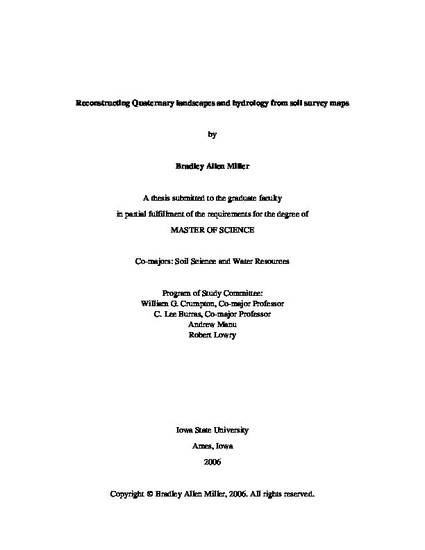
This study was done to investigate the pre-settlement condition of the southern Des Moines Lobe landscape, with particular interest in the hydrological function of depressional wetlands. Soil survey maps were used to identify the soil formation environment from soil properties observed today. Understanding the factors of soil formation and geomorphology allows historical reconstructions of the landscape, hydrology, wildlife habitat, and potentially other areas of interest. This study interpreted and managed soil survey data to efficiently create a Quaternary geologic map, identify the extents of historical depressional wetlands, deduce information about the water budget of these wetlands, and estimate the region's non-contributing area. The Quaternary geologic map produced from the categorized soil map units added resolution and qualitatively showed close agreement with currently available Quaternary geologic maps.
Comparison of depressional wetland soil extents with mapped existing wetlands in the National Wetland Inventory showed that 98.5% of the depressional wetland area from the Des Moines Lobe of Iowa has been drained. Watershed to wetland area ratio was used as an indicator of the wetland water budget. Despite the potential of landscape to influence the watershed to wetland area ratio, climate showed a generally smooth trend. Of the climate components, evaporation showed the strongest effect. This illustrates the dominant role that evaporation has on the hydrology of depressional wetlands and this landscape. Geographic information systems (GIS) methods were used to produce a consistent and reproducible delineation of the region's non-contributing area. Using this method, a map of the non-contributing area of the southern Des Moines Lobe was created that showed that 60% of the area was historically non-contributing.
For three watersheds on the southern Des Moines Lobe, wetter climate conditions were found to increase potential percent contribution to annual stream flow from drainage of a previously non-contributing area. In these watersheds it was estimated that drainage of the whole non-contributing area had the potential to approximately double the quantity of water flowing in the respective streams. The twelve geologic zones used in this study show a parallel between time and stream network advancement except for areas affected by large quantities of water flowing in a glacial outlet river.
Available at: http://works.bepress.com/bradley_miller/11/
